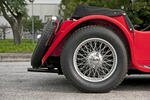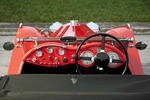1938 Jaguar SS100 3½-Litre roadster
1938 Jaguar SS100 3½-Litre roadster Châssis n° 39044 Moteur n° M523E. Estimation €380,000 - 440,000 (£310,000 - 360,000). Photo: Bonhams
Lancée en 1936, la SS100 était la première vraie voiture à haute performance produite par SS Cars Limited et utilisait un moteur à soupapes en tête conçu par Weslake dans un châssis de SS1 raccourci. Aux yeux de William Lyons, le patron de SS Cars, l'apparition d'un moteur à soupapes en tête justifiait un nouveau nom pour la voiture qui raconta plus tard : 'J'ai tout de suite pensé à Jaguar, car le nom sonnait bien à mes oreilles' (Jaguar fut adopté comme nom de la marque en 1943, les lettres SS ayant acquis à cette époque une réputation peu enviable).
À l'origine, SS signifiait Swallow Sidecar & Coachbuilding Company, une société fondée par William Walmsley à Blackpool qui s'était lancée dans l'automobile en 1926. Son premier succès important fut une séduisante carrosserie de berline sur base d'Austin Seven qui avait été conçue par l'associé de Walmsley, un certain William Lyons. La marque acquit sa notoriété avec la SS1 dont le châssis exclusif était fourni à Swallow par Standard qui lui fournissait par la même occasion le moteur six cylindres à soupapes latérales et la boîte à quatre vitesses. Malgré ses performances anémiques, la SS1 servit de modèle aux futurs Jaguar, combinant une allure sportive avec des caractéristiques au-dessus de la moyenne pour un prix modique.
Quand apparut la sportive SS90, en 1935, William Heynes avait été engagé comme directeur technique. Reposant sur un châssis de SS1 raccourci, la SS90 montrait à nouveau les indéniables talents de styliste de Lyons, avec son long capot, ses ailes ondulantes, ses portes échancrées et son arrière tronqué qui en faisaient l'archétype de la sportive des années 1930. Malgré ses 90 miles à l'heure (145 km/h), la SS90 était handicapée par les limites de son moteur à soupapes latérales, un défaut auquel allait remédier une autre recrue de Lyons, l'ingénieur en circulation des fluides Harry Weslake. Lancée en 1936, en même temps que la berline 2½ Liter, la sportive SS100 Jaguar marquait la première apparition du nom Jaguar. Magnifiquement dessinée dans la même veine que sa devancière SS90, la nouvelle SS reposait sur un empattement plus court et avait recours à une version modifiée du six cylindres Standard de 2663 cm3, dotée des cylindres à soupapes en tête de Weslake et alimentée par des deux carburateurs SU, qui développait 104 ch.
Bien qu'elle ait été une agréable voiture de tourisme, la SS100 était commercialisée d'abord comme voiture de compétition. Son premier succès, un peu inattendu, ne se fit pas attendre, Tommy Wisdom qui faisait équipe avec son épouse, remporta le très éprouvant International Alpine Trial en 1936, devant une Bugatti, pointant les projecteurs sur la jeune marque que découvrait le public du continent. C'était le premier des nombreux succès en rallye de la marque qui remporta des victoires de classe au RAC Rally en 1937 et 1938 et au classement général à nouveau dans l'Alpine Trial de 1938. Environ 198 modèles 2½ Litre et 116 modèles 3½ Litre avaient été construits lorsque la guerre mit prématurément fin à la production de la SS100.
Selon son certificat du JDHT, la voiture portant le numéro de châssis 39044 a été construite en mars 1938 et livrée au concessionnaire de Wolverhampton, Charles Attwood, pour lui servir de véhicule de démonstration. Elle était rouge avec intérieur noir et capote assortie, sa première immatriculation étant, pense-t-on, BJW 507.
Exportée plus tard aux États-Unis, elle devint la propriété de l'architecte bien connu John Lyon Reid de San Francisco. Apparemment, lorsque Reid ne fut plus en mesure de conduire en raison de la maladie, il mit la voiture en dépôt au Briggs Cunningham Museum. Lorsqu'il mourut, sa veuve la vendit à un certain Michael Gartner de Newport Beach en Californie (copie d'une lettre de Briggs Cunningham dans le dossier).
À la fin des années 1980, la voiture fut achetée par un Belge vivant près d'Anvers. Importée en Italie, pense-t-on en 1997, elle subit une restauration de la carrosserie vers 1998, tandis que sa mécanique fut restaurée par un spécialiste de la marque en Italie du nord, il y a trois ans. Décrite par son vendeur comme étant en excellent état général, la Jaguar a participé sans aucun problème à plusieurs rallyes de régularité ces dernières années et s'est montrée très en forme lors d'un récent parcours d'essai. Les documents comprennent les papiers d'immatriculation italiens, ((Libretto et Certificato di Proprieta), identité FIVA, papiers ASI et le certificat du JDHT mentionné plus haut.
La SS100 était l'une des sportives les plus rapides et des plus efficaces de son temps, comme en témoigne les comptes-rendus de compétition tant avant qu'après guerre. C'est une rare occasion d'acquérir un exemplaire de ce modèle qui fut à l'origine de la légende Jaguar. 39044 est éligible pour un grand nombre de manifestations historiques prestigieuses.
1938 SS100 Jaguar 3½-Litre Roadster Chassis no. 39044 Engine no. M523E
Launched for 1936, the SS100 was the first real high-performance model produced by SS Cars Limited and used a new Weslake-developed overhead-valve engine in a shortened SS1 chassis. The introduction of the OHV unit was considered to justify the adoption of a new name for the series, SS Cars boss William Lyons later recalling 'I immediately pounced on Jaguar as it had an exciting sound to me.' ('Jaguar' would be adopted as the marque name in 1943, 'SS' having by then acquired a somewhat tarnished reputation).
'SS' originally stood for the Swallow Sidecar & Coachbuilding Company, which had been founded in Blackpool, England by William Walmsley. The company branched out into motor manufacture in 1926, its first major success being an attractive sports saloon on the Austin Seven chassis, the design being the work of Walmsley's partner, one William Lyons. Marque status arrived in October 1931 with the launch of the SS1, the chassis of which was supplied exclusively to Swallow by Standard, who also provided the six-cylinder sidevalve engine and four-speed gearbox. Although unspectacular in performance, the SS1 went some way towards establishing the pattern for future Jaguars, combining sporting good looks with a better-than-average specification and all at a bargain price.
By the time the SS90 sports car arrived in 1935, William Heynes had joined as Chief Engineer. Based on a shortened SS1 chassis, the SS90 again demonstrated Lyons' consummate skill as a stylist, its long bonnet, smoothly flowing wings, cut-away doors and truncated tail making it every inch the epitome of the 1930s sports car. Although good for 90mph, the SS90 was handicapped by the limitations of its sidevalve engine, a deficiency that would soon be rectified by another of Lyons' new recruits, gas-flow consultant Harry Weslake. Launched in 1936 alongside the 2½-Litre saloon, the SS100 Jaguar sports car marked the company's first use of the 'Jaguar' name. Beautifully styled in the manner of its SS90 predecessor, the newcomer employed a shorter wheelbase and a revised version of the 2,663cc Standard six which, equipped with Weslake's overhead-valve cylinder head and breathing through twin SU carburettors, now produced 104bhp.
Although a fine touring car, the SS 100 was marketed as primarily for competition work. Its first major success came early, if somewhat unexpectedly, when Tommy Wisdom, crewed by his wife, won the arduous International Alpine Trial in 1936, beating Bugatti and bringing the fledgling marque to the attention of the Continental public. This would be the first of many successful rallying forays, including class wins in the RAC events of 1937 and 1938, and the Alpine (outright) again in 1948. Around 198 2½-Litre and 116 of the later 3½-Litre cars had been made by the time SS 100 production was prematurely ended by the outbreak of war.
According to its accompanying JDHT certificate, chassis number '39044' was manufactured in March 1938 and despatched to distributor Charles Attwood of Wolverhampton, serving as the company's demonstrator. The original finish was red with black interior and matching hood, and the first registration is believed to have been 'BJW 507'.
Subsequently exported to the United States, the car was owned there by well known architect and motoring enthusiast, John Lyon Reid of San Francisco. Apparently when Mr Reid became too ill to drive he loaned the Jaguar to the Briggs Cunningham Museum. After Mr Reid passed away, his widow sold the car to a Michael Gartner of Newport Beach, California (see copy of letter from Briggs Cunningham on file).
In the late 1980s the car was purchased by a Belgian living near Antwerp. Believed to have been imported to Italy in 1997, it underwent a bodywork restoration circa 1998, while three years ago the mechanicals being restored by a marque specialist in Northern Italy. Described by the vendor as in generally excellent condition, the Jaguar has performed faultlessly on regularity rallies in recent years and it certainly sounded lovely on a recent inspection and short test drive. Accompanying documentation consists of Italian registration papers (Libretto and Certificato di Proprieta), FIVA Identity Card, ASI papers and the aforementioned JDHT certificate.
The SS100 was one of the fastest and best-handling sports cars of its day, as its competition record both before and after the war bears witness to. Representing a rare opportunity to acquire an example of the model that can be said to have started the Jaguar legend, '39044' is eligible for a wide variety of the most prestigious historic motoring events.
Bonhams. LES GRANDES MARQUES DU MONDE AU GRAND PALAIS. Paris. 6 Feb 2014. http://www.bonhams.com

/https%3A%2F%2Fprofilepics.canalblog.com%2Fprofilepics%2F1%2F0%2F100183.jpg)
/https%3A%2F%2Fstorage.canalblog.com%2F03%2F02%2F119589%2F96711876_o.jpg)
/https%3A%2F%2Fstorage.canalblog.com%2F11%2F31%2F119589%2F94773502_o.jpg)
/https%3A%2F%2Fstorage.canalblog.com%2F20%2F83%2F119589%2F94772815_o.jpg)
/https%3A%2F%2Fstorage.canalblog.com%2F26%2F72%2F119589%2F75604929_o.jpg)
/https%3A%2F%2Fstorage.canalblog.com%2F59%2F60%2F119589%2F26458628_o.jpg)



















/http%3A%2F%2Fstorage.canalblog.com%2F89%2F81%2F119589%2F126345035_o.jpg)
/http%3A%2F%2Fstorage.canalblog.com%2F10%2F31%2F119589%2F122244736_o.jpg)
/http%3A%2F%2Fstorage.canalblog.com%2F74%2F85%2F119589%2F112433521_o.jpg)
/http%3A%2F%2Fstorage.canalblog.com%2F04%2F74%2F119589%2F112253219_o.jpg)